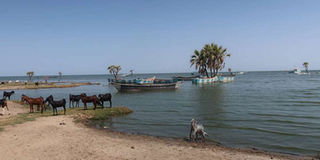Beautiful Jade Sea behind harsh desert

Lake Turkana. The lake, which joined the World Heritage List in 1997, is dotted with a few rocky islands. PHOTO | FILE | NATION MEDIA GROUP
What you need to know:
- The tranquillity of this lake is also a great attraction for tourists with its three national parks — Sibilioi, Central Island and South Island.
- What makes a tour to the desert lake even more appealing is the annual Marsabit/Lake Turkana Cultural Festival, in Loyiangalani Town.
In one of the hottest, harshest and remotest edges of Kenya lies Lake Turkana, the world’s largest desert lake.
Also known as the Jade Sea because of its greenish-blue hue, Lake Turkana’s waters stretch seemingly into a never-ending panorama of black lava and rocks from a view in the dusty town of Loyiangalani in Marsabit County.
The lake, which joined the World Heritage List in 1997, is dotted with a few rocky islands.
Here, there are no sandy beaches lining the shore. It’s all rock and extremely barren.
It’s arguably one of the most beautiful of all the Rift Valley lakes, surrounded by stunning geographical features, and it supports a large variety of animals in a beautiful conservation area.
With its increasing popularity among leisure travellers, Lake Turkana provides a unique experience away from the hustle and bustle of modern living.
TOURISM
Getting to the lake is not easy if you chose to use road transport. But it is adventurous and you get rewarded by picturesque visions of one of the most untamed areas left in Africa. The history of Lake Turkana is rich.
In 1975, the government renamed the lake after the Turkana people, one of the communities that has lived on its shores for centuries.
It was once known as Lake Rudolf in 1888 in honour of Prince Rudolf of Austria.
The tranquillity of this lake is also a great attraction for tourists with its three national parks — Sibilioi, Central Island and South Island.
The parks have been listed by Unesco as heritage sites. Measuring approximately 4,349 sq miles, Lake Turkana does not have an outlet and loses its water through evaporation.
It is fed by three rivers: Omo of Ethiopia, Turkwel and Kerio. On June 28, 2018, a panel of the United Nations Educational, Scientific and Cultural Organisation (Unesco) added Lake Turkana — a conservation hotspot in Kenya and a candidate site for the birthplace of mankind — to the list of endangered World Heritage Sites.
WILDLIFE
The lake’s islands are breeding grounds for the Nile crocodile and hippopotamus, while the lake itself is important to migratory birds according to conservationists.
It is said that the shores have revealed the oldest known remains of the Homo habilis that lived two million years ago, making it a possible site of mankind’s birth.
What makes a tour to the desert lake even more appealing is the annual Marsabit/Lake Turkana Cultural Festival, in Loyiangalani Town.
The festival was launched by then-German ambassador to Kenya Walter Lindner in 2009 with a focus to peace-building among the many communities that reside on the shores of Lake Turkana.
The communities include the Samburu, Turkana, El-Molo, Dassanach, Gabbra, Borana, Konso, Wata and the Burji.
This year’s edition, which took place between December 5 and 7, was a rich display of cultural dances, authentic fashion developed over the years, music, architecture and the diverse arts of the different ethnic communities that live by the lake.
Is there a site you want us to feature? Write an e-mail to [email protected]





